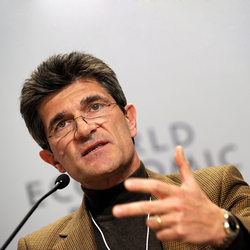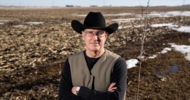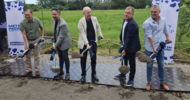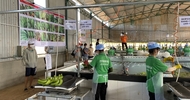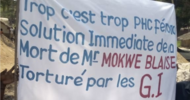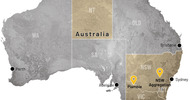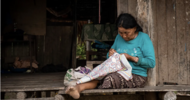Lombard Odier | 16 January 2024
The ‘coffee blueprint’: regenerative farming promises Nature revolution at Davos 2024
The ‘coffee blueprint’: regenerative farming promises Nature revolution at Davos 2024
The 54th annual meeting of the World Economic Forum in Davos, Switzerland began with a warning and a message of hope. On day one of the conference, speaking at an event hosted by Lombard Odier, renowned climate scientist Professor Johan Rockstrom told delegates: “We are on our way to crash through 1.5 degrees [of global warming]. We will overshoot.” However, he added, the Paris Agreement target could still be brought “back from the brink.” The solution, he said, is “Nature”.
As finance, business and political leaders gather in the remote Swiss resort, Nature has emerged as a key theme. Alongside efforts to tackle rising geopolitical tensions, concerns over economic growth, and the possible threat posed by Artificial Intelligence (AI), the Forum is calling for delegates to work together to build a transparent, long-term strategy for Energy, Climate and Nature.
Increasingly, despite the challenges of landscape degradation and biodiversity loss, scientists and policymakers are seeing Nature not just as a problem to be solved, but as a solution – one that could have a profoundly positive impact across society, from mitigating the climate crisis to creating growth, jobs, and new, sustainable economy.
Nature’s real estate
Opening the event – a high-level discussion that included some of the world’s leading voices from finance and science – Hubert Keller, Lombard Odier’s Senior Managing Partner, said, “We should think of Nature assets like real estate assets. We restore and refurbish real estate. The question is how do we do the same thing for essential Nature assets?”
Many in the finance industry are focussed on voluntary carbon markets, he said, “but at Lombard Odier we are more cautious about carbon markets. Ultimately, big corporations, who are the natural buyers of carbon credits, are going to concentrate on real emissions reductions on the ground. So we have concerns over whether voluntary carbon markets can achieve the scale we need.”
Instead, he said, “We are focussing our attention on regenerative food production. Why? Because 85% of the pressure on Nature stems from our food systems, so it is the development of regenerative food production that will unlock value in Nature’s assets. It will increase the life and resilience of those assets. It will increase the carbon sequestration. And it will create nature-positive commodities at a time when the world is putting a price on the environmental cost of production. Economic systems powered by Nature’s regenerative approach can outcompete today’s economic systems.”
Professor Johan Rockstrom agreed. Following 2023’s “year of extremes”, and a “huge warning” from recent research showing that the Brazilian Amazon rainforest has turned from vital carbon sink into a carbon source, he said: “regenerative action will help Nature continue to provide an essential carbon sink. We can make at least a 20 gigaton shift in global emissions by moving from extractive value chains, such as monoculture agriculture, to regenerative value chains.”
Starting with the Global South
Éliane Ubalijoro, CEO of the Centre for International Forestry Research and World Agroforestry (CIFOR-ICRAF), picked up on the importance of protecting the world’s remaining forests. “Although those rainforests look so lush, they are very fragile,” she said. “What an asset we’re losing.”
Agroforestry – a regenerative form of agriculture that combines farming with forest restoration and management – will be key to their protection, she explained. “We know that 65% of soils in Africa are degraded. How are we going to have productive, sustainable, prosperous value chains when our soils are degrading?”
Highlighting the importance of deploying technological innovations to work in harmony with nature-based solutions, she said, “The work that we do through our land degradation surveillance framework, that combines satellite data with remote sensing, shows that when you institute regenerative agriculture and agroforestry you can take unproductive soil, soil that has stopped responding to fertiliser, and turn it into productive soil with high organic content. And it will become like a sponge, holding water whether you have a lot of rain or long periods of drought. We can use the power of Nature to bring life back into soils to become the engine of prosperous food systems.”
“75% of people on the planet are fed by smallholder farmers,” she continued. “We need to connect the finance and the people with power with the wisdom of the smallholder farmers. It needs long-term thinking, a long-term investment strategy.”
Hubert Keller agreed. “We need to start with the Global South because this is where the greatest climate urgency lies,” he said, with smallholders in many tropical nations both most exposed to the threat from global warming and least able to deploy the capital needed to adapt. “It is also where the greatest value can be unlocked most rapidly,” he said. However, “Achieving regenerative food production at scale is not cheap.” The question, he asked, is, “Where will the money come from?”
Shifting capital
Morten Rossé, Head of Nature and Climate at holistiQ Investment Partners, Lombard Odier Investment Managers, explained: “the challenge is that 95% of the climate solution is upstream. It is in the farms. But the farms are not where the money is being made. Most of the added value is not in the farms. It’s in the brand. So how do we take that downstream investment and shift it upstream?”
Turning to coffee production as an example, he introduced Sebastian Nielsen, CEO of Slow Forest coffee. One way to shift capital upstream, Sebastian Nielsen said, is to shorten the value chain. “We grow coffee, we process coffee, we roast it and sell it to corporates. That is rare in the coffee industry. Usually coffee changes hands 15 to 20 times. Think about the loss of value. Think about the loss of transparency. By cutting out the middlemen we captured the value so we could redistribute it back to communities and back to Nature.”
To create further upstream value, Slow Forest has also committed to regenerative farming. Sebastian Nielsen explained: “We are raising capital to buy degraded farms with low productivity. We plant 350 trees and 20 different tree species per hectare including fruit trees and fast-growing trees, to get cover that gives good shade for growing coffee and to mimic nature as fast as possible. This attracts biodiversity and creates a habitat for wildlife. You can taste the result. The coffee is better quality. And it has a negative carbon footprint. It’s opening a market where consumption can help us raise the capital, create the return, and regenerate more land.”
The coffee blueprint
Andrea Illy, Chairman of Italian coffee giant illycaffé, and Co-founder and Chairman of the Regenerative Society Foundation, highlighted why coffee is a bellwether crop for the impact of climate change on farming, and also why it is at the forefront of the food systems transformation. “By 2050, 50% of suitable land for coffee will no longer be suitable due to climate change,” he said.
“In the two largest growing regions, most coffee farmers live below the poverty threshold. There are twelve and a half million farmers working across millions of hectares, mostly in the Global South. If we do nothing for these smallholders they will be out of business. The change has to come from us, because we are the beneficiaries of their work. In order to safeguard the market we have to invest. We have to elevate our practises and create resilient value chains.”
For Lombard Odier, Morten Rossé said, coffee is providing a blueprint for a new, scalable way to invest in Nature. “We drink two billion cups of coffee every day. It’s a more than USD 200 billion value chain. Investors could just invest in a conventional monoculture farm in Indonesia, for example, or Colombia, and get an average of 5% return on investment. But this also comes with the risk of investing in emerging markets.”
But when you produce coffee regeneratively you can measure the added carbon value. And the land is going to become more valuable, not less valuable as it often does with monocultures. And you can increase yields and sell your coffee directly to large coffee buyers or end-markets. We believe we can meet emerging market risks with a potential 20% total return on investment.”
The strategy for Lombard Odier, he explained, is to create nature-based investment assets by deploying capital into monoculture coffee plantations near forests and to re-forest them, creating shaded, biodiverse agroforests. As soil health improves, and carbon sequestration increases, land value will rise over time. Simultaneously the coffee produced will command a premium from corporate buyers committed to reducing the environmental impact of their business models.
Investing to protect the global commons
At Lombard Odier, we believe that coffee is just the first step in a fundamental re-shaping of our relationship with Nature. Across multiple commodities and industries, from coffee to cocoa and from clothing to cosmetics, regenerative production will offer investors a “nature premium”, as we move from today’s extractive value chain to a nature-positive, regenerative value chain.
For Johan Rockstrom, this shift is key to protecting the “global commons”. “We have to regulate systems that are not owned by anyone,” he said. “We have to recognise that tipping points, like ice sheets and rainforests, are global commons that have to be cherished and managed collectively. That is the global public good for a stable planet.”
“Assuming we succeed in reducing global emissions by moving from extractive value chains, such as monoculture agriculture, to regenerative value chains, then you can create a USD 1 trillion market. Imagine the investor opportunity,” he concluded.


